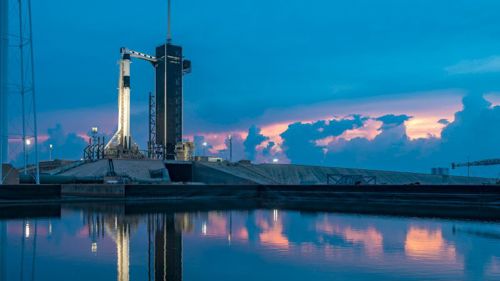
What's Happening in Space: January 2024
- 3rd Jan 2024
Happy 2024 everyone! If you're curious about what's going on over our heads this month, Dhara Patel is here to guide you! Dhara works as a Space Expert at the National Space Centre, helping educate people on space science, stories.
Read on for her round-up of some notable space and science events coming up in the weeks ahead...
3rd January –Earth will be at perihelion, its closest distance to the Sun in its orbit
Since the intensity of light changes as the square of the distance, sunlight reaching the Earth at perihelion is about 6.5% brighter than sunlight reaching the Earth at aphelion (furthest distance from the Sun which occurred last July). But we still experience colder temperatures on average in the northern hemisphere winter because of the axial tilt of the Earth – we are tilted away from the Sun at this time of year. The angle of incoming sunlight has a greater effect on the average temperature than the relatively small change in distance caused by the elliptical orbit of the Earth around the Sun.
Check out our illustrations about the seasons and Earth’s orbit created by Michelle Barnett – one of our graphic designers!
3rd/4th January – peak of the Quadrantid meteor shower
It’s one of the major showers of the year, with up to 110 meteors per hour at its peak, produced by material from asteroid 2003 EH1. The meteors will radiate from the northern tip of the constellation of Boötes (in the northwest as the Sun sets and the skies darken) but can appear anywhere in the sky. Peaking on the night of the 3rd and morning of the 4th, the last quarter moon situated in the constellation of Virgo will rise above the eastern horizon after midnight so may block out several of the meteors this year. The radiant will continue to rise higher into the sky during the early morning of the 4th, so it might be best to head out to a dark location and observe in the predawn hours when the radiant will be high in the east. The Quadrantids peak only lasts a few hours due to the shower's thin stream of particles and the fact that the Earth crosses the stream at a perpendicular angle. The shower is known for its blue meteors with fine trains and also its bright fireballs. Find out more about the Quadrantids 2024 in our meteor shower blog: https://www.spacecentre.co.uk/news/space-now-blog/quadrantid-meteor-shower-2024/
8th January – Astrobotic Technology – Peregrine Mission 1
Delayed from Christmas Eve 2023, the Peregrine lunar lander from Astrobotic Technology is set to launch (at 7:18am) from Cape Canaveral, Florida on the ULA’s (United Launch Alliance) Vulcan Centaur rocket, hoping to become the first successful commercial mission to the Moon. NASA is working with several American companies to deliver science and technology to the lunar surface through the Commercial Lunar Payload Services (CLPS) program. Astrobotic Technology, with its Peregrine Mission 1, will carry several NASA and commercial payloads to the lunar surface. It will also be the Vulcan Centaur's maiden flight - it's a two-stage-to-orbit, heavy-lift launch vehicle. Scheduled to land 23rd February, if successful, it will likely beat the Intuitive Machines IM-1 private lunar mission, another of NASA’s CLPS initiative, which is scheduled to launch on 10th February at the earliest.
11th January – new moon (11:57am)
The new moon on the 11th will occur in the constellation of Sagittarius. We have a blog on ‘phases of the moon’ written by Mike Darch in our Space Comms team: What are the Phases of the Moon? (spacecentre.co.uk).

12th January – Mercury at greatest western elongation
Mercury will be at its furthest separation from the Sun on 12th January when it reaches greatest western elongation, making it a great time to try and spot the Sun’s closest planet. Look to the southeast around sunrise – it will be close to the horizon, so you’ll need a clear view without tall buildings and trees.
14th January – close approach / conjunction of the Moon and Saturn
During the morning of 14th January, the waxing crescent moon will be in conjunction (sharing the same right ascension – coordinate) with Saturn. At the time of conjunction, the moon and Saturn will be below the south-eastern horizon. So instead look for the pair later on that day in the south-western sky when the sun begins to set up until around 8:00pm when they’ll fall out of view, setting below the horizon. In the early evening they should be high enough in the sky to spot but it’s always helpful to have a clear view without tall buildings and trees to see them easily. They’ll be visible to the naked eye and could be seen together through a pair of binoculars but will be too far separated to be seen within the field of view of a telescope. Find out more about oppositions and other astronomical phenomena in our blog written by David Southworth in our Education Team: Astronomical phenomena (spacecentre.co.uk).
17th January – Axiom Mission 3
A SpaceX Falcon 9 rocket will launch (10:11pm) a Crew Dragon spacecraft on the program’s 12th flight with astronauts. The commercial mission, managed by Axiom Space, is commanded by a former NASA astronaut, Michael López-Alegría. Three passengers, including a representative of the Turkish Space Agency, Alper Gezeravci, will fly on this two-week commercial mission to the International Space Station. It will be piloted by Walter Villadei from the Italian Air Force and Marcus Wandt will become the first astronaut from the ESA 2022 class to make a spaceflight (ESA proposed him for the mission and upon his selection he transitioned from reserve to professional astronaut and joined ESA on 1st June 2023). The Falcon 9’s first stage booster will land on a drone ship in the Atlantic Ocean.
18th January – close approach / conjunction of the Moon and Jupiter
During the evening of 18th January, the first quarter moon will be in conjunction (sharing the same right ascension – coordinate) with Jupiter. At the time of conjunction (roughly 8:45pm), the pair will be up in the south-western sky. They’ll remain high enough above the horizon until just after midnight - their separation will increase throughout the night, but they’ll still be in close approach of one another. They’ll be visible to the naked eye and could be seen together through a pair of binoculars but will be too far separated to be seen within the field of view of a telescope. Check out the astronomical phenomena blog above to find out more about conjunctions and other astronomical phenomena.
25th January – full moon (05:54pm)
Known as the Wolf moon (according to the old Farmers’ Almanac), it marks the time of year when hungry wolves would be heard howling in the dead of winter. Check out the “Full Moon: Full Facts” blog written by Mike Darch in our Space Comms team: https://spacecentre.co.uk/blog-post/full-moon-facts/.
26th January – Virgin Galactic's Galactic-06 mission
Due to launch 26th January (2:30pm) Galactic 06, will take off from Virgin Galactic's Spaceport America in New Mexico. VSS Unity (the crewed spacecraft) will aim for suborbital flight through the help of a double-bodied carrier aircraft called VMS Eve, which will take off from a runway at Spaceport America. Once at an altitude of around 15km, VSS Unity will release from VMS Eve, after which it will fire its rocket engine and travel the rest of the way to space on its own reaching an altitude of roughly 85km – higher than the Karman line / boundary of space as defined by NASA. The suborbital flight will last long enough to grant the Galactic 06 crew members a few minutes of weightlessness. While both VSS Unity and VMS Eve will have a pilot and commander, it will be the first flight with 4 paying customers, and no astronaut instructor on board; the private astronauts onboard will be from the Ukraine and California (US), Texas (US), Austria and California (US).

January?? – Starship – Test Flight 3
Following the first test flight of the fully integrated Starship rocket on 20th April 2023 and a second attempt on 18th November 2023, SpaceX are gearing up for a third test flight. Starship is made of the Super Heavy booster – a first stage rocket with 33 of SpaceX’s raptor engines. On top of that sits the upper stage, rather confusingly also called Starship, which hosts 6 engines. When fully developed this will be a completely reusable rocket – both first and second stages. Back in April the upper stage failed to separate from the booster a few minutes into its flight and SpaceX experienced a ‘rapid unscheduled disassembly’ a.k.a. an explosion. In November, the stages separated but, shortly after, the first stage had multiple engine failures and after beginning its boost back burn, ended up exploding. Meanwhile the Starship second stage continued to fly for over 8 minutes, but an anomaly caused the flight termination system to kick in, so it too was destroyed after reaching an altitude of 148 km. Having completed a static fire test at the end of 2023 (igniting the engines to test them while the rocket stays bolted to the launch mount), SpaceX are awaiting a launch license for a third test flight to complete their objective of sending a Starship upper stage craft around the Earth before splashing down in the Pacific Ocean near Hawaii, with the Super Heavy first stage coming down in the Gulf of Mexico shortly after launch. Find out more about Starship and SpaceX’s other rocketry achievements in this blog by Ed Turner in our Education team: https://www.spacecentre.co.uk/news/space-now-blog/spacex-the-world-s-rocket-giant/
Please note: As this summary is created at the end of the month before, dates (especially launch dates) can often change or be updated, so this content may become outdated - we always recommend checking on the relevant organisation's pages.
